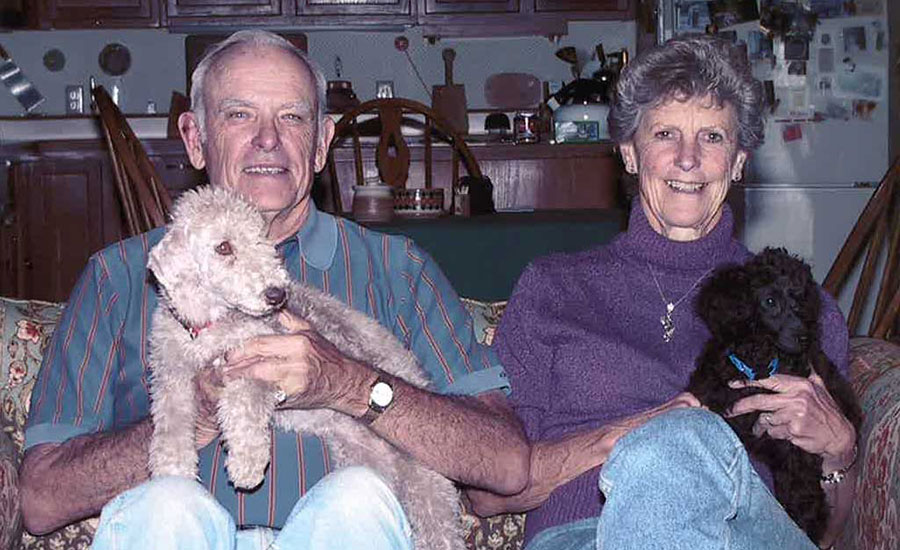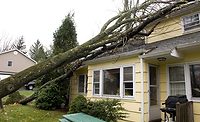Fathers and Sons
Treasured Legacy: Bradford Roof Management
Within eight decades, Bradford Roof Management has grown from a small sole proprietorship in the local Billing, Mont. area into a small but mightily influential company whose name and intellectual property extend far beyond the Northern Rocky Mountain region.

America is a land of mythologies with stories of toil and reward shaping our collective consciousness as far back as the republic's founding. It's how we envision ourselves and is the image we export worldwide. None of these narratives is more enduring than that of the pioneer, furthering westward expansion.
Within that tale is a secondary and equally appealing throughline: the scrappy entrepreneur starting a family-run business with related hands on deck. For example, the one-off burger joint in California that eventually became a globally recognized brand: Would you like a side of fries with your Big Mac?
In that vein, and recognizing June is traditionally a “Father’s Day”-inspired month for storytelling, meet Tom Bradford, president of Bradford Roof Management in Billings, Mont. Bradford and his two sons, Jens and Jake, have a reasonably rare distinction in America's myth-making pantheon: the men are third- and fourth-generation roofing contractors, respectively, operating a legacy concern Tom’s paternal grandfather, Harry, founded in 1942.
When Harry Bradford first purchased an existing roofing contracting company more than 80 years ago, the enterprise grew steadily during its first decades. It was in the early 1980s that then-Bradford Roofing took a consequential turn, which happened to coincide with the rise of personal computers, while under the leadership of Harry’s son — and Tom’s father — John Bradford.
John was a pioneer in the roofing industry, and his influence has been widely recognized with his techniques having become industry best practices. John’s foresight in the power of technology helped transform a once-analog trade into a quantifiable enterprise by solving a once-vexing dilemma: how to sustain ongoing relationships with clients in an industry where capital improvements — like roofing — are measured in decades versus months or years.
Today, Bradford Roof Management is a multi-divisional concern reaching well beyond Montana and Wyoming's rustic Big Sky country, offering prospective clients science-based insight into roof design, customizable maintenance programs, and new construction services.
Before all that success, it took the prodding of a young wife whose husband was laid low by the Great Depression to convince him that, despite no practical knowledge of roofing, a local contracting company available for purchase was a smart move.

A photo of John Bradford, the founder's son and father to Bradford Roof Management's current principal, Tom, circa 1960.
Photo courtesy of the Bradford family.
Finding Stability in Chaotic Times
As classic origin stories go, Brandford Roof Management hits the marks: a man looking to feed his family gambled on a dream, found a sweet spot in operations, and built a driver for generational wealth.
As the country headed into World War II in the early 1940s, Harry, then 42, was forced into a career pivot. He worked as a lorry driver for Northern Pacific, the rail carrier that helped fuel the country’s Westward expansion after its founding in 1864 by then-President Abraham Lincoln. Our national mythology of the “pioneer spirit” was burnished around that time.
With the country’s economic growth still anemic from the Great Depression, Harry was not insulated from corporate downsizing. He was first reassigned to driving trucks for the rail career before being let go just as America plunged into war. Too old to join the service and in need to support a wife and child, he tapped into that other American ethos: small business proprietorship.
Harry purchased a local roofing contractor operation in Billings at the urging of his wife, Tom Bradford’s grandmother, Louise. As Tom recalls hearing when his grandfather expressed doubts about his knowledge to run a roofing business successfully, Louise’s no-nonsense reply sums up the Bradford family’s mantra: “You're very smart, very capable; you're going to be just fine.”
And for $2,000 in 1942 (nearly $37,000 in today’s dollars), Harry Bradford purchased a local roofing contracting business in Billings, Mont., changed the name to Bradford Roofing and creating a lasting legacy.

John and LaVetta Bradford enjoying the fruits of retirement. Photo courtesy of the Bradford family.
John Bradford, Wunderkind
As Harry and Louise’s only child, John Bradford likely had a great weight placed upon his shoulders to assume his father’s business. After one semester at Eastern Montana College, he met his future wife — Tom’s mother — LaVetta. The new couple married and moved to Missoula, Mont., where John enrolled at the University of Montana, earning a bachelor’s degree in business administration. Following graduation, he joined the Navy and served during the Korean War.
John didn’t immediately join the family business after returning stateside, instead taking a job as a landman for the Mobile Oil Co. before joining his father in the mid-1950s. He was fortunate to have 10 years to learn the business with his father by his side before the company founder passed away in 1966, leaving John to assume the helm. With a growing family and the heady building boom of the 1960s, John and LaVette enjoyed the fruits of their labor. The couple had three children: Tom, his older brother Dane and their sister, Tracy.
John got to work in ways that now seem foregone in their approach but were vanguard at the time. He networked like a politician, joining on behalf of Bradford Roofing multiple trade organizations and civic institutions, including the National Roofing Contractors Association, the Midwest Roofing Contractors Association — each of which he would later become president of — and helped found the Montana Roofing Contractors Association. John’s involvement in the community was also widespread. He served on several boards throughout his career, including the Yellowstone Boys and Girls Ranch board of directors, the Billings Chamber of Commerce, Deaconess Hospital, Northern Rockies Cancer Treatment Center and Rocky Mountain College.
Civic institutions also played a central role in shaping his stature, with membership in various local country clubs, the Billings Optimist Club, the Billings Downtown Rotary and the Red Lodge Rotary clubs. He was also a Mason and member of the Scottish Rite.
By the mid-1960s, John’s reputation as an industry leader was firmly cemented. Tom recalled a story involving his father and an issue with a then-new product on the market by a leading national roofing supply manufacturer that was touted as a breakthrough but, in practice, failed spectacularly. It was a quality defect that had garnered media attention but had not hit the critical mass usually needed for a product recall, which was far less frequent in those times.
Not content to accept mediocracy, John consulted his attorney, who offered a highly-choreographed plan for redress.
“'The first thing I want you to do is to join every trade association, regional and national; then take five names randomly from each one of those membership rosters and write them a letter specific to this material and detail the issues you have found,'” Tom said, recalling the moment.
The response was galvanizing.
John Bradford’s attorney then proposed calling a meeting between the interested trade association members who also had poor outcomes with the material and the product manufacturer’s representative, who subsequently arrived at the gathering with three of the company’s corporate attorneys in tow.
“His attorney told [John], ‘We’re going to be fashionably late to this thing, and I want you to go into the conference room first, sit down and then I’ll come in, and you can introduce me,’” Tom said. “My dad went in; the room was filled with all these people he reached out to, along with the [corporate] reps, and, you know, everyone was laughing and sitting back, including the local [manufacturer’s] rep, whom my dad considered a friend.”
Shortly after the meeting began, the manufacturer’s rep said to Tom’s father, “John, it's such a shame, you know, we thought you guys were a good company, and this just goes to show, you really don't have the moxie, you don't have what it takes to make this [product] work, and this is what separates the men from the boys,’ that kind of a thing,” Tom recalled.
At that moment, Tom said, his father’s attorney, Rocky Brown, walked into the meeting room where John introduced Brown to the corporate reps, explicitly mentioning the gentleman was his attorney.
“Rocky greets everyone, saying it was nice to meet you and the like, and then he put his briefcase down on the desk and pulled out a copy of the Kansas City Star,” Tom added.
The newspaper had previously run a substantial investigative piece — parked top of the fold on page 1A — about the failure of the product in question. Brown spread the splayed article on the desk and let things play out.
“After that, the rep and the attorneys, in their three-piece suits, all leaned in so fast to look at this article describing [defects the manufacturer had just tried to deflect failure for onto Bradford and the others] they actually bumped heads,” Tom said, sporting a subtle grin on the coup. “Everybody was dumbfounded, and [the corporate reps] came back, and they said, ‘What will it take for this to go away?’”
In 1978, John was awarded the MRCA’s James McCawley award, the highest honor bestowed by that trade organization, recognizing an individual who made “outstanding contributions to the roofing industry.” In 1983, John was elected president of the NRCA, the nation’s oldest roofing trade group, founded in 1871.
During his tenure as NRCA president, John became convinced a new, relatively affordable technology called the personal computer could change how roofers operated and began evangelizing their utility to NRCA members. He also recognized that cultivating an ongoing relationship with every client through regular roof system maintenance would ensure brand loyalty and change the boom-bust nature of roofing’s revenue stream.

From its founding in 1942, Bradford Roof Management has evolved from a local Billings, Mont. contractor to a national management and consulting firm.
Relationship-building, or; the Rise of Bradford ‘Routine’ Maintenance
Tom heaps plaudits on his father’s long-game approach to a business once used to one-and-done jobs. Install a roof, collect payment and then on to the next customer. It’s a Sisyphean task that his father realized was shortsighted.
Using then-groundbreaking computer technology, John developed a software program allowing every client's job to be indexed and tracked. And, in an arguably brilliant move, creating an added-value proposition of roof system maintenance that would help extend the roof’s life through regular yearly inspections to maintain system integrity.
The added-value component was a game-changer for Bradford Roofing. Instead of one-and-done, John constructed an ongoing relationship with every client, explaining how a roof’s typical lifespan could be extended 10-15 years beyond the industry standard, approximately 20 years, through routine inspection and maintenance.
That shift in outlook allowed Bradford Roofing to become an ongoing presence in the operational maintenance of commercial and planned-unit residential facilities. John’s vision also enhanced his father’s contracting business into an asset-management firm, setting the ground for what would eventually become Bradford Roof Management.
John’s two sons were onboarded to the family business in the mid-1980s. Tom and his brother, Dane, were each given a 10% equity stake by their father and helped grow the firm. Tom says business was a matter of volume during those first years. As a commercial roofing firm in a state that doesn’t necessarily have constant or ample work in that space, the approach was to bid out nearly every open call for work through the Builder’s Exchange.
“If there was a job that went through the Builders Exchange, and it had anything to do with roofing, we would bid on it,” Tom said. “If we heard about it, we would bid on it. It was volume, and it was a lot of work, and it made nobody happy, then in the late 1980s, the market [began going] to hell.”

Tom (far left) Bradford and his wife, Carol, with their two sons, Jake and Jens. Tom and Carol's sons are the fourth generation of Bradford men to join the family business.
Business 2.0 and Welcoming Gen 4
As the recession of 1990-91 blossomed with unemployment nearing 8%, according to the Bureau of Labor Statistics, and GDP contracting by 3.6% in the fourth quarter of 1990, Tom said the company looked inward for a better strategy to weather the storm.
“We really started looking at ourselves and examining what kind of company we wanted to be,” Tom said. “We figured we spent 99% of our time bidding public work [projects], and we get a low percentage of it at best; the greatest return on our efforts actually was through negotiated contracts and the concepts of service and maintenance because, as a property owner, you're losing money if your roof doesn't last 30 years.”
In this new paradigm, where less volume and higher margins became the operating model, and working smarter, not harder, produced more revenue with less uncertainty, Bradford Roofing began to transform into what it is today: a multi-divisional operation that handles contracting, maintenance and service, and consulting for third parties.
By 1994, John, on the cusp of turning 65, decided to retire. Tom says his father had developed a well-devised succession plan years earlier, and both sons had been ostensibly running daily operations ahead of John’s departure. Tom noted how John’s succession plan was so well-planned that Mass Mutual, the large life insurance and financial services company, bestowed Bradford Roof Management with its Family Business of the Year award based partly on succession planning. Bradford’s business won recognition at both the state and national levels in the small business category.
John, the second-generation owner of Bradford Roofing, retired with his wife, LaVetta, and enjoyed seeing his children and grandchildren grow before passing away in 2011 at age 81.
Tom’s mother retained principal ownership of Bradford Roof until her death in 2020. Her sons each gained a 50% interest in the family business, and within a year, Tom acquired his brother’s stake and became its principal.
In 2022, the NRCA established the John Bradford Volunteer Award, presented at the organization’s annual convention and given to a roofing industry professional who “has consistently demonstrated outstanding acts of volunteerism with NRCA and in his or her community.” In 2023, the award was presented to Bill Collins, former president and CEO of GAF Materials Corp.
Tom’s sons, Jens and Jake, are now the fourth generation of Bradfords to help further the legacy begun by their great-grandfather, Harry. Jens, 29, earned a bachelor’s degree in business administration from Montana State University and joined the firm in 2012. Younger brother Jake, 25, earned a bachelor’s degree in mechanical engineering at Montana State and joined his father and brother shortly after graduation.
Jake, who is engaged to be married this summer, recognizes how large the legacy of his forefathers looms. His surname represents something beyond himself, he acknowledges, but it doesn’t cow him. In fact, he says, it’s kindling for working harder.
“It's a self-motivator,” Jake says. “For me to try and do right by my family and, [by extension] the company. I'm very fortunate to work for my dad and with my brother … I've learned more from my dad than I could have ever learned through school or learn through anything really [and] maybe, at some point, I could at least get to the point where I'm half as capable as he is when it comes to the roofing industry. It means a lot to me to work with my family; we have a very good bond.”
His older brother, Jens (a Scandinavian derivation of John), echoed much of what Jake expressed. Working with their father and his younger brother is an ideal few get to experience. Each brother brings their own strengths to the table, as Jens explained. While Jake mans field operations as a site superintendent, Jens leans into business operations, negotiating contracts, dealing with clients and vendors, and garnering new business.
“A big reason why Jake, my dad, and I work so well together is [that] we always have each other's backs; that's a big thing,” Jens explains. “Something will happen, and it's like, ‘Okay, well, I got your back on this; what do you need from me?’”
Jens also spoke of the value he places on his relationship with his brother and how each has a skill set that complements the other. In time, those complementary traits will be helpful whenever Tom decides he and Carol have more to see than Big Sky country and announces his own retirement.
“I mean, I worship the ground Jake walks on … I couldn't ask for a better coworker, brother, and mentor,” Jens says. “He has a mechanically-oriented brain and knows so much about commercial roofing systems and how they're put together; my strengths lie more in interpersonal skills, which is why I’ve taken an active role in the consulting division.”
For Tom, his wife and his children, the mythologies of the American canon are seemingly thriving. Father and sons, working well together, finding success in business and knowing what priorities are of intrinsic value. A word all three men each used in describing the other, and also in describing how to manage business affairs, was “integrity.”
“You are only as good as your name on the street,” Tom said. “My father believed that, and he learned from his father; my sons know that to be true, and our employees know that to be true. Be honest, do good work, and the rest falls into place.”
Looking for a reprint of this article?
From high-res PDFs to custom plaques, order your copy today!







